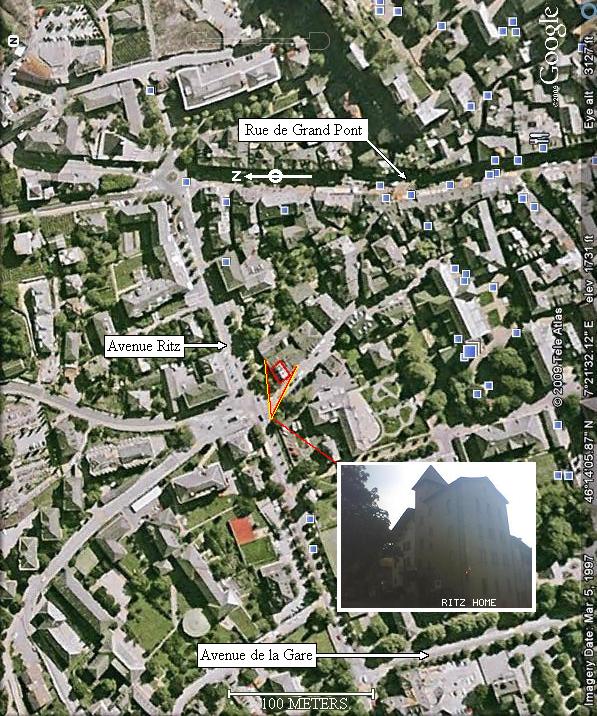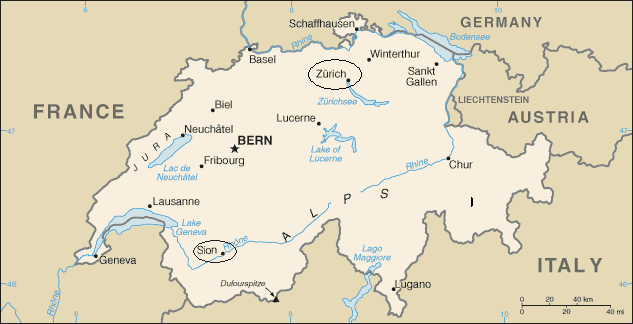Abbreviated Biographical Sketch of Walter Ritz
(Walther Heinrich Wilhelm Ritz)
Latest update 27 Jul 2019
Prepared as an appendix in
Lorentz and Poincaré Invariance - 100 Years of Relativity,
Advanced Series on Theoretical Physical Science - Vol. 8
Jong-Ping Hsu, Yuan-Zhong Zhang,
Copyright © World Scientific, 2001, New Jersey, London, Singapore, Hong Kong.
Used with permission.
Walter Ritz was born in Sion in the southern Swiss canton of Valais
on February 22, 1878. His father, Raphael Ritz, a native of Valais,
was a well-known landscape and interior scenes artist. His mother
was the daughter of the engineer Noerdlinger of Tübingen Germany.
After an all-to-short but brilliant career in physics Ritz died at
age 31 in Göttingen Germany on July 7, 1909.
As a specially gifted student, the young Ritz excelled academically
at the Lycèe communal of Sion. In 1897 he entered the Polytechnic
school of Zurich where he began studies in engineering. He soon found
that he couldn't live with the approximations and compromises
involved with engineering so he switched to more mathematically
exacting studies in physics. (Albert Einstein was one of his
classmates.)
Following a severe bout with what may have been pleurisy he transferred to
Göttingen Germany in 1901 to get away from the humid climate of Zurich.
There his forming aspirations were strongly influenced by Voigt and
Hilbert.
Ritz's dissertation concerned a mathematical expression to predict the
frequencies of the lines in atomic spectral series. His classical
approach to the phenomenon involved elastic atomic vibrations. (In
retrospect it should be noted that this approach could be considered
as similar in spirit to our current ideas about the vibrational origin of
molecular spectra.) His oral doctoral examination was passed summa
cum laude.
Ritz's work in spectroscopic theory eventually led to what is
still known as the Ritz combination principle. His interpretation of the
underlying mechanism was rejected but his 1908 mathematical formulation
for the frequencies of the lines in a given spectral series
multiplied by Planck's constant is the Rutherford-Bohr 1913 quantization
rule for quantum mechanics.
In the spring of 1903 Ritz visited Leiden to attend a series of lectures
by H.A. Lorentz on electrodynamics problems and his new theory of
electrons. In June that year he was in Bonn at the Heinrich Kayser
institute where he found the hitherto undiscovered m=4 diffuse series line
of potassium which was predicted in his dissertation. In November that year
Ritz began work on producing infra-red photographic plates at the École
Normale Supérieure in Paris. In July 1904 his health failed and he
returned to Zurich.
During the following three years of unsuccessfully trying to regain his
health Ritz was outside the scientific centers. It wasn't until 1906 that
he began to publish again. This in spite of his poor health.
In September 1907 he moved to his mother's home town of Tübingen,
which was a center for spectral research.
In 1908 he relocated to Göttingen where he qualified as a privat
dozent (private lecturer) at the University. There he produced his opus
magnum Recherches critiques sur l'Électrodynamique Générale.
In the First Part of his "Critical Researches" Ritz delineated in
depth his version of the shortcomings of the continuum-ether
Maxwell-Lorentz electromagnetic theory and urged science to avoid the
strange consequences associated with adopting Einstein's special theory of
relativity. That theory had been formulated to bring the Maxwell-Lorentz
partial differential equations into harmony with our failures to detect
our motion through the ether. In the Second Part Ritz outlined a
way to take Lorentz's ideas back to the classical electrodynamic theories
of Gauss, Weber, Riemann, and Clausius by use of his time asymmetric
finite-speed elementary interactions.
Ritz warned his readers that his preliminary approach was
flawed because in order to remain faithful to Lorentz's
formulations he had adhered to the superposition theorem which
amounts to action without reaction. In essence, Ritz's model, as
enunciated in 1908, is not applicable to optics for macroscopic
distances in dispersive media such as the Earth's atmosphere. Yet it may
be found to be applicable on a microscopic scale (millimeters down to
atomic dimensions) and for distances on the order of perhaps one light
year in the vacuum of interstellar space. (See Fox's article in the sources
below.)
In 1908-1909 Ritz and Einstein held a war in Physikalische
Zeitschrift over the proper way to mathematically represent black-body
radiation (the radiation problem from the ultraviolet
catastrophe) and over the theoretical origin of the second law of
thermodynamics. The final paper in that series
looks as though it could have been written by the journal editors. It's
language judges in favor of Ritz. Six weeks after it's publication Ritz
was in a higher court. (See Fox.)
Robert S. Fritzius
Starkville, Mississippi
Sources used.
Ritz, W., Gesammelte Werke - Oeuvres, Published by the Société Suisse de Physique, Gauthier-Villars, Paris, 1911.Forman, P., Dictionary of Scientific Biography, XI, 475, Charles Scribner's Sons, New York, 1975.
Fox, J. G., Am. J. Phys., 33, 1, 1965.
Additional Information
Below is a GoogleEarth image of a northern part of Sion showing the location of Ritz's family home. The picture of his four-story home (inset) was made in September 2009.

Sion, Switzerland showing location of Ritz's home (North is to the left.)
Ritz was buried in Zurich, but in (either 1995 or 1997) the cemetary was bulldozed and his grave is no longer identifiable.

Map of Switzerland Showing Locations of Zurich and Sion
Home | Up one level | Previous | Next
Top